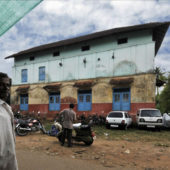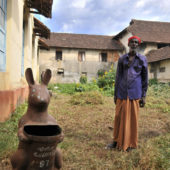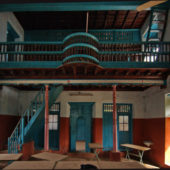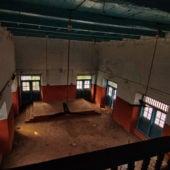Although the last Jews left Mala in the 1950s, it was a home for Jews for over 2,000 years.
Jews have a very long history in Mala, located in the Kerala State of India, near Cochin. Some believe as early as 72 CE Jews immigrated to Mala for trade and settlement, as it was an important trading district before the time of Christ. The name Mala may have originated from the Hebrew word “Mal-Aha”, meaning, “Center of Refuge.” There is an ancient Jewish Malayam folk song indicating that the wood used for the synagogue was donated to Joseph Rabaan in 1000 CE by the Rajah of Cranganore. Apparently, the original 11th century synagogue was torn down for unspecified reasons and a new building was built in 1400, later renovated in 1792. This history is in conflict with missionary Rev. Thomas Dawson, who was stationed in Kochi in the beginning of 1817. Dawson visited the Mala Synagogue and observed that it was still in ruins following Tipu Sultan’s attack during the Second Anglo-Mysore War, which took place during the early 1780s. Missionary Dawson notes that after 25 years of observation, the Synagogue was not renovated or re-built. Other sources date Mala Synagogue’s initial building as 1597, after the Kerala Jews had been driven away from Cranganore by the Portuguese, which is significantly later than the previous histories given. Regardless of which version of its earlier history is correct, in 1909 the Synagogue was either upgraded or re-built upon the original foundation. Either way, the Synagogue was built, renovated and added-onto over time. There is a wood carving with inscriptions in Hebrew and Malayalam, located along the balcony frieze, which dates the current Synagogue building back to 1909. The breezeway and gateway appear older; it is possible that these have survived from an older period.
Mala Synagogue is located in a prominent position in the center of town. A major thoroughfare dead-ends at the gatehouse and leads to the Jewish cemetery, which is a short drive away. Since 1955, no Jews have lived in the city of Mala and that is when then Synagogue closed. On December 20, 1954, 300 members of the Jewish community in Mala moved en masse to Israel. Control of the Synagogue was given over to the local municipality, with the agreement that it would be maintained, and not used as a slaughterhouse, or as a house of prayer. The building has been readapted as a venue for cultural, educational and communal functions. The furnishings and religious artifacts have been lost.
The Synagogue is a two-story structure with a gatehouse, which served as a foyer with communal spaces downstairs and a Jewish school upstairs. It was linked by a covered breezeway (which is now filled-in) to the Synagogue. As is traditional with synagogues in Kerala, Mala Synagogue features a shallow wooden balcony in dark and teal wood, which overlooks the two-story prayer room. The façade is yellow downstairs and white upstairs, with three traditional windows upstairs. Corners of the building, plaster over stone and brick, are broken. Exterior steps (which have now been sealed closed) led to the women’s gallery upstairs, which was separated from the sanctuary by a latticed screen. The two-story women’s gallery is situated at the western end of the prayer room, upstairs, and features balustrades in dark and teal wood. It is accessed by a flight of stairs from inside the sanctuary. Today, the interior is painted terracotta on the lower half of the walls and white above, with paned and shuttered windows, with a teal blue ceiling, and teal woodwork. The sanctuary is now empty, but once a central bema was built on a stone base and the Aron Kodesh was situated on the eastern wall.





